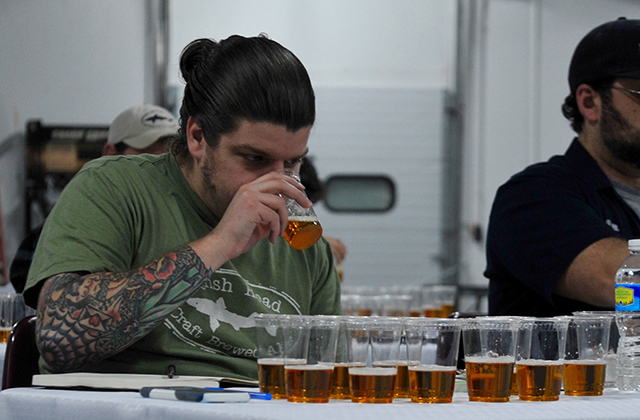
No matter how much you spend on scientific equipment, the tongue of the consumer is still going to be the gateway to profit for a brewery.
Brand recognition and attenuation of that brand loyalty comes into play with quality and consistency. Dogfish Head Brewing in Milton, Delaware takes that to heart and has daily tasting panels of both finished products and even straight from the fermentor beer to make sure the brew is identifiable and the quality is there.
Dogfish Head quality control supervisor Ryan Mazur says he is spoiled by the amount of attention, time and money that his brewery puts into making his team a part of the process toward quality.
“They pride the program,” he said. “We taste things multiple times and sleep well at night knowing that we are putting out a consistent product.”
Mazur, who has been with Dogfish Head for 11 years and helped start the sensory program in 2006 with little knowledge of the process. After courses at the Siebel Institute of Technology in Chicago and learning from watching at Coors, New Belgium, Sierra Nevada and Boston Beer, he developed his own program.
“I have tweaked it here and there over the years, but nothing crazy,” he said. “It works.”
Every beer from every fermentor gets tested. It also gets tested before heading to packaging, usually after some smaller fermentors have been blended.
“Nothing goes through without being tasted by a trained evaluator panel,” Mazur said. “There are many instruments regarding color, alcohol or bittering units, but none of those can tell you if it tastes right. A beer can be done correct analytically, but we need to evaluate it to make sure it meets expectations for the brand and maintains consistency throughout.

“A “60 Minute” IPA today should taste like a “60 Minute” next month.”
Panelists are comprised of only the brewery’s staff, meaning anyone employed at Dogfish Head, not just the production side. Mazur’s panelists come from accounting, sales, IT and everywhere else.
“I don’t care where you are in the brewery, your title doesn’t mean you are a better taster than someone else,” Mazur explained. “Just because you are in brewing or production rather than somewhere else. Tasting is a skill set and I encourage anyone in the brewery to do this.”
It’s rigorous training he said.
He teaches a class of 10 people at a time, twice a year. The course adds up to about 25-30 hours of tasting beers spiked with flavor additives that don’t belong in each brand of the brewery’s beer.
Teaching people by example, and using memory mapping by repeating key phrases during the sampling of the off-flavor helps panelists learn and store that information.
“If we all talk the same and taste the same, I can facilitate the taste panels all the same,” Mazur said. “If the taste panel says this “60 Minute” is isomeric, I know to go to the raw material department and find out what is going on with the hops.”
Each panel gets between three to seven samples in a session. Mazur explained that more than seven can leave palates fatigued.
Each group of samples get randomized in which order the samples are served.
“It’s just human nature that the first sample you taste is going to be compared to the sample you had before,” Mazur said. “We rotate the samples in all the booths so all the samples get a fair shot.”
One of the things Mazur has done to streamline his system is that he has narrowed the off-flavors he uses to spike the samples with from 35 to 21. Those other 14, he said, were attributes that rarely, if ever, found its way into a Dogfish product and it was a waste of time to train his panelists on them.
Product release panels are asked a few questions during the sampling: Is it free of off-flavors (or ‘attributes that don’t belong,’ as Mazur puts it); and does it meet expectations? If it doesn’t, then tell him why. He does not ask if the beer is sellable. Preference is not judged he said.
The panelists aren’t just there to judge, they are being judged as well. Mazur tracks the panelist’s attendance and ability to get spikes correct to make sure his groups are solid and on point with knowing the products.
“Brand recognition is important. You can’t be served a 60 and call it a 90, even if I tell you it’s a 90,” he said. “The panelist needs to identify that the brand isn’t correct.”
Panelists are all given a validity score to make sure their opinion matters. Attendance and the ability to get spikes correct helps the score go up. If a score goes down, they can be retrained.
“Maintaining the panel integrity is a big deal,” he said. Mazur noted that people can volunteer to re-train on certain off-flavors if they are struggling with it.
Elite panelists are used for other types of tastings, including scaling exercises when products are moved from a small-batch into the large-batch brewhouse. Oxidation tastings also occur, checking shelf life of products, starting at one month, up to six months.
This amount of work isn’t cheap though. Each spike that Mazur uses is $20 and to train 20 people it can cost upward of $10,000.
“Even some big breweries still go with the ‘thumbs up, thumbs down’ approach, but we do it different because we have to,” Mazur said. “Our portfolio is about 30 beers and we have to maintain the integrity because we ask a premium price for our beer and there is a level of expectation that comes with the purchase of our beer so we focus on the quality of our beer.”
If the cost for such an elaborate sensory panel gives heart palpitations to some smaller breweries, Mazur assured that even little things can add up to better quality and consistency.
“I would focus on brand profiling,” he said. “You can’t hit a target if you haven’t defined one and break it down to what you want into four different things: appearance, flavor, aroma and mouthfeel.”
Sensory is tough since you are measuring perception Mazur said.
“Someone like a brewmaster needs to set what they want, a target to maintain. If you don’t have that, you will drift. And you need to revisit that target to make sure that you are attaining last year’s and even last month’s goal.
“Find what’s right first before you going to look to see what is wrong.”



2 Trackbacks / Pingbacks